Climate change is a growing and serious threat to Pakistan, which is one of the most vulnerable countries, while contributing almost nothing to global emissions. The impacts of climate change are increasingly unpredictable and are destroying such that in August 2022, floods devastated and submerged a third of Pakistan. At the other end of the climate change scale, record heat waves occur almost every month, with glaciers retreating. The impacts of environmental stress create threats to human life, ecosystems, and ultimately socio-economic stability and say, human development. The real estate sector in Pakistan lies in this dilemma. While it creates poverty and environmental degradation through unapologetic urbanization and similarly damaging carbon-intensive construction practices, it is also a target of climate risks such as flooding, heat waves, and water scarcity.
The purpose of this blog is to dissect the two-way relationship between climate change and real estate within Pakistan. It deserves to be discussed that the industry is causing environmental harm, as well as climate change will cause harm to property comfort, prices, and safety. Most importantly, it will provide some thoughts on sustainable urban planning, green construction, and climate resilient infrastructure that introduces an imagination where real estate development creates economic growth whilst being kind to the environment.
How Real Estate Contributes to Climate Change in Pakistan
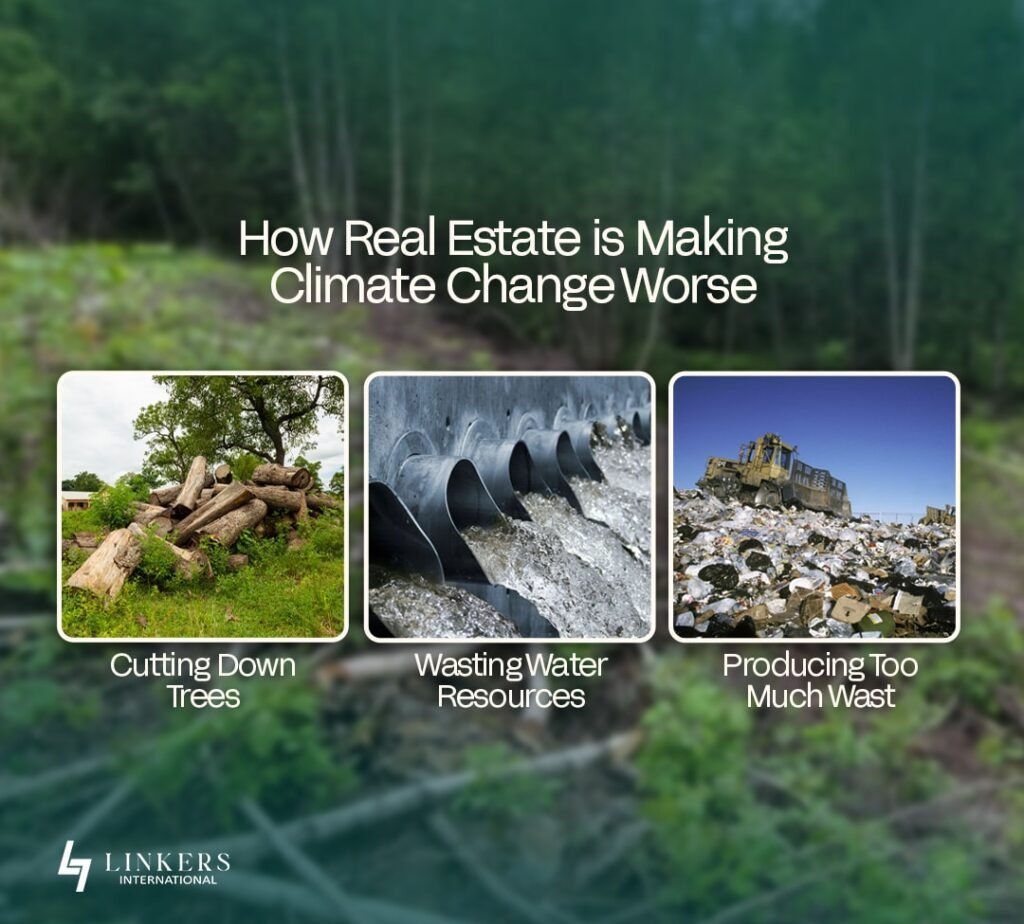
Pakistan’s real estate sector is growing very quickly. In almost every city, we see new housing societies, tall buildings, shopping malls, and commercial centers being built. This fast development brings many benefits, such as creating jobs, boosting the economy, and giving people more places to live and work. However, it also has a serious impact on the environment. As more land is used for construction, natural areas like forests and green spaces are being destroyed. This leads to problems like deforestation, pollution, and increased use of energy, which all contribute to climate change. So, while real estate growth may seem like a sign of progress, it is also silently making environmental problems worse in Pakistan. Here’s how real estate is making climate change worse in Pakistan:
1. Cutting Down Trees and Green Areas
Real estate development often clears forests, farmland, and green spaces to make room for buildings. This deforestation reduces the number of trees that absorb carbon dioxide, leading to higher greenhouse gas levels. It also increases urban heat, making summers hotter and more uncomfortable.
2. Using Material That Harms the Environment
Construction relies heavily on materials like cement, bricks, and steel, whose production emits large amounts of carbon dioxide. In rural areas, outdated brick kilns burn coal and garbage, releasing toxic smoke that pollutes the air and harms human health. This makes construction a major contributor to air pollution and climate change.
3. Building That Waste Energy
Most buildings in Pakistan lack insulation and ventilation, making them energy-inefficient. People use air conditioners and heaters more, increasing electricity demand. Since most electricity comes from fossil fuels, this raises carbon emissions and contributes to climate change, while also causing power shortages.
4. Wasting Water Resources
Construction projects use large amounts of water but rarely include systems for saving or reusing it. Groundwater is over-extracted, especially in major cities, and there’s little rainwater harvesting or recycling. As real estate expands, water scarcity worsens.
5. Producing Too Much Waste
Construction generates a lot of waste—cement, bricks, plastics, and metals—that is often dumped in open areas, rivers, or roadsides. This pollutes land and water, harms wildlife, and damages public health. Without proper waste management, the environmental damage keeps growing.
How Climate Change Affects Real Estate in Pakistan
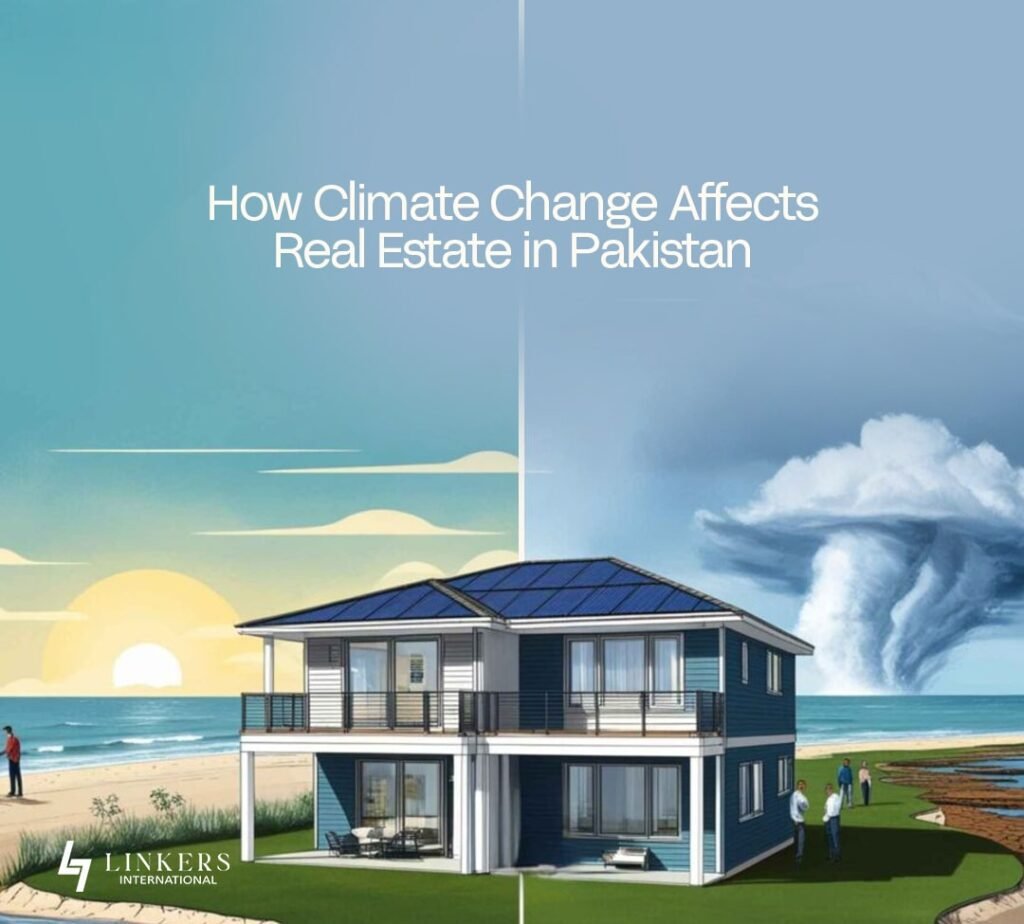
Climate change is not only affected by real estate but also poses serious obstacles and challenges to the real estate itself. Extreme weather events, rising temperatures, and instability in the environment are making real estate development risky. It makes real estate more expensive and less sustainable. Here is how :
Floods and Waterlogging
Frequent and intense rainfall, especially during the monsoon season, is becoming a major issue in cities like Karachi, Lahore, and Rawalpindi. Poor drainage systems in many housing societies cannot handle heavy rain, leading to waterlogging and urban flooding. Properties get damaged, foundations weaken, and roads become impassable. This reduces the value of real estate and discourages future investment in flood-prone areas.
Heatwaves and Urban Heat Islands
Heatwaves in Pakistan are becoming more frequent and intense due to climate change, especially in big cities like Karachi, Lahore, and Multan. These extreme heat events not only affect people’s health but also impact real estate. One major reason is the way cities are built. In many urban areas, government and private builders use a lot of concrete, asphalt, and closely packed buildings, with very little green space or trees. This design traps heat and creates “urban heat islands”—parts of the city that are much hotter than nearby rural areas. These higher temperatures make living conditions worse and reduce the comfort and value of real estate in those areas.
Glacier Melt and Water Scarcity
An often-overlooked but critical threat to Pakistan’s real estate and urban stability is the rapid melting of glaciers feeding the Indus River system, which over 220 million people rely on. Glaciers in the Himalayas, Hindu Kush, and Karakoram are melting faster than ever due to rising global temperatures. While increased meltwater may temporarily boost river flow, it leads to long-term water shortages as glaciers shrink and rivers dry up during crucial periods. This worsening water scarcity is already affecting cities like Lahore, Karachi, and Islamabad. Real estate developments, especially large-scale projects, often lack sustainable water strategies and rely on unregulated borewells that deplete underground aquifers. The absence of rainwater harvesting, greywater recycling, and low-flow plumbing further intensifies the crisis. The impact goes beyond inconvenience. As water becomes less accessible, the cost of living rises, municipal services are strained, and the long-term value of properties in water-stressed areas may drop, weakening investor confidence. To protect the future of real estate in Pakistan, water conservation must be built into every project. This includes water-efficient technologies, sustainable groundwater use, and climate-resilient urban planning that considers the long-term effects of glacier retreat.
Smart Planning for Safer Cities
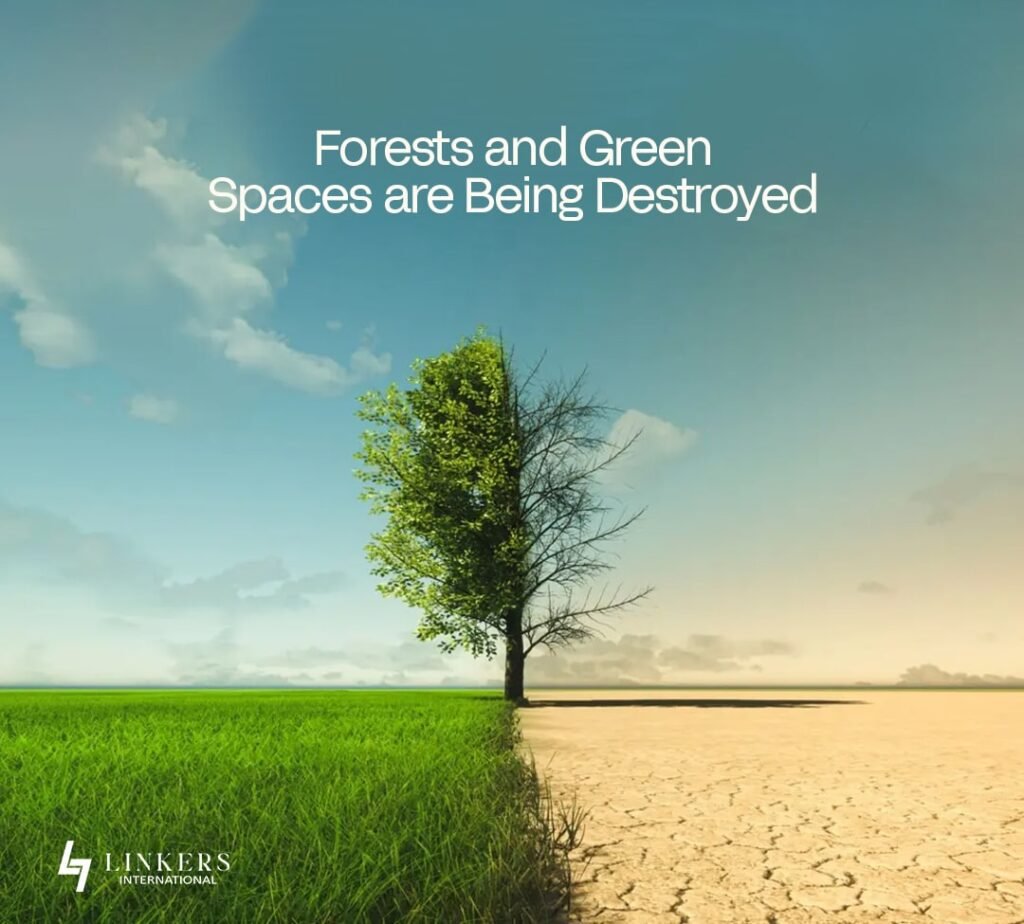
As Pakistan faces rising risks from climate change, including floods, heatwaves, water scarcity, and pollution, there is a growing need for smarter urban planning. “Smart planning” means designing cities that are not just bigger, but better prepared to handle future environmental challenges. It also means making sure real estate development happens in a way that protects both people and the planet. In many regions of Pakistan, particularly in cities like Lahore, Karachi, and Islamabad, where rapid change is happening, substantial urban growth and change often occur without any planning at all. Housing societies are often built in flood zones, green zones are replaced by concrete, and essential services such as drainage and water, and energy infrastructure are not updated quickly enough to keep pace with the rapid growth of the size of the city itself. With fewer livable areas already devoted to concrete and urbanized regions, these cities will become much more climate vulnerable in adverse weather events. Smart planning can help to bring about change. Here are some main points on how smart planning can support the development of safer and climate-ready cities:
1. Protecting Natural Ecosystems in Cities
Green areas such as parks, trees, wetlands, and open spaces act as natural buffers. They help absorb rainwater, reduce flood risks, lower city temperatures, and clean the air. Unfortunately, many real estate developments remove these natural features. Smart planning includes protecting and even expanding green zones in and around cities. Urban forests, green belts, and eco-friendly landscaping can make cities more livable and more resilient.
2. Avoiding Construction in High-Risk Zones
Many new housing societies are being constructed on a riverbank, in a floodplain, or in low-lying areas without any consideration of the ecological implications. While these areas may appear suitable from just the visual perspective, they are disaster zones during flooding or after heavy rainfall. Good planning uses scientific data, maps, and risk assessments to determine the appropriate locations for building and where it isn’t. Doing this helps to limit property damage and loss of lives.
3. Improving Drainage and Waste Management Systems
In cities like Karachi and Rawalpindi, even moderate rains can cause severe urban flooding due to blocked drains and poorly managed sewer systems. When real estate expands without upgrading these systems, cities suffer. Smart city planning focuses on modern infrastructure like wider stormwater drains, underground pipelines, and waste recycling systems that support clean and safe urban living even during extreme climate events.
4. Planning for Climate-Friendly Transport
Road congestion, air pollution, and traffic-related emissions are becoming a real problem for cities in Pakistan. In smart planning, complete neighborhoods are planned, where people can walk, bike, or use public transportation instead of relying on just cars. These options are environmentally friendly and reduce emissions, and they will promote healthier and better-connected neighborhoods.
5. Making Communities Part of the Planning
Real estate projects that ignore the needs and voices of local people often create problems instead of solutions. Smart planning involves local communities in decisions about how and where to build. This ensures developments meet real needs while also helping people understand how to care for the environment. By using smart planning strategies, Pakistan’s cities can become stronger and safer in the face of climate change. This approach doesn’t stop development—it makes development smarter, fairer, and more sustainable. For real estate developers, this means higher long-term value, less risk, and a better reputation. For residents, it means safer homes, cleaner air, and more reliable infrastructure. As the effects of climate change grow stronger, smart city planning will no longer be a choice but a necessity.
Sustainable Real Estate Practices
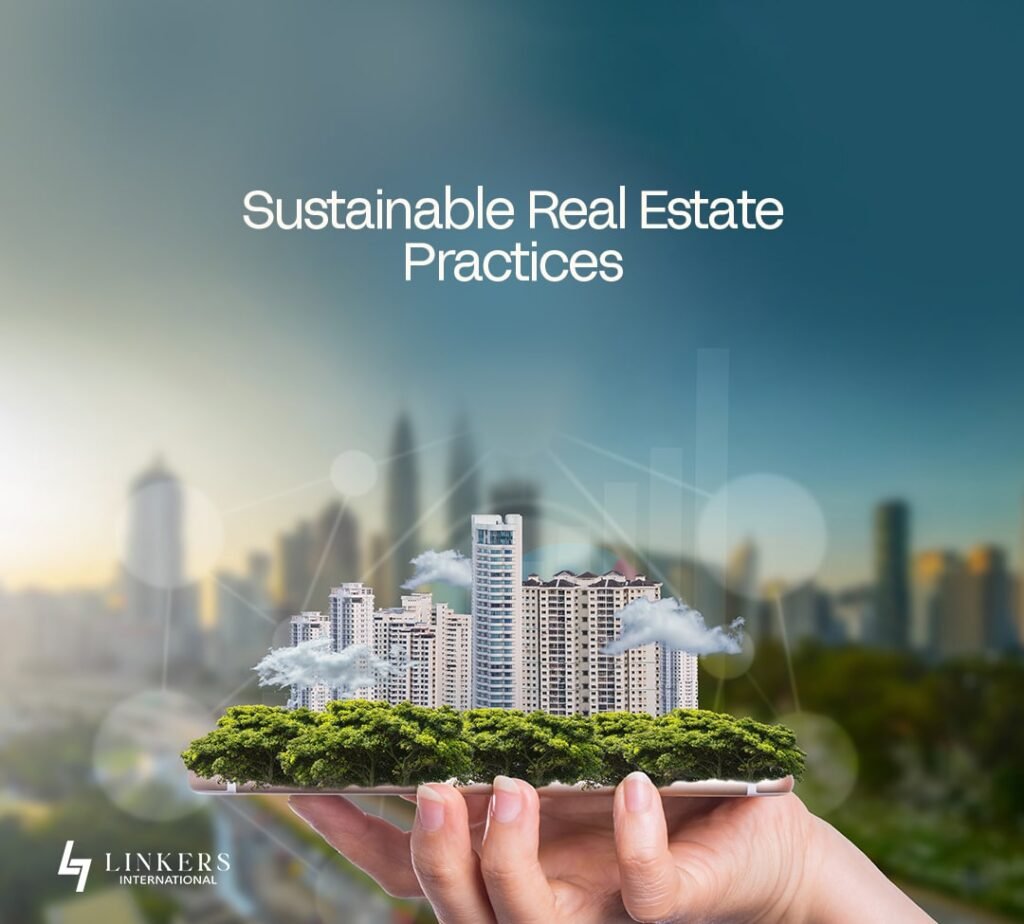
The climate crisis is getting worse, which means the real estate industry in Pakistan needs to abandon traditional construction practices and embrace a new reality of greener, environmentally sustainable practices. Sustainable real estate means that properties are designed, built, operated, and managed in ways that minimize negative environmental impact, maximize energy and water efficiency, and improve human health and well-being. It is not only a sustainable way to build—it is also going to be necessary for long-term sustainability and value in the future real estate market.
In Pakistan, our cities are struggling with pollution, lack of water, extreme weather, and poor infrastructure. Sustainable real estate practices can be among the processes to help improve conditions in which we all live and work to create safer, cleaner, and stronger communities.
There are several sustainable practices that the real estate industry can start to embrace:
1. Using Green Building Materials
Traditional materials like cement and steel have high carbon footprints. Greener alternatives such as fly ash bricks, recycled steel, compressed earth blocks, and bamboo use less energy, reduce emissions, and perform better in extreme weather. These materials also help cut construction costs and support eco-friendly development.
2. Energy-Efficiency in Building Design
Many buildings in Pakistan are not adapted to the climate, leading to heavy reliance on cooling and heating. Sustainable design includes:
- Proper insulation
- Cross-ventilation
- Energy-efficient doors/windows
- Solar panels
These features reduce energy use, cut electricity bills, and lower emissions.
3. Water Conservation Techniques
With water scarcity worsening, buildings must adopt water-saving systems like:
- Low-flow fixtures
- Rainwater harvesting
- Greywater recycling
These methods reduce water waste and help conserve groundwater, especially in cities facing shortages.
4. Waste Prevention and Reuse
Construction waste is often dumped irresponsibly. Sustainable practices include:
- On-site waste sorting and recycling
- Modular building elements to reduce surplus
- Recycling stations in buildings
- Resident education on waste management
These steps minimize environmental damage and promote cleaner surroundings.
5. Building for Long-Term Use and Flexibility
Short-lived, low-quality construction harms both the environment and investment. Sustainable buildings should:
- Use durable, climate-resilient materials
- Allow for future reuse or modification
- Incorporate climate-aware design
This ensures long-term value and reduces environmental impact.
Conclusion
Climate change is not a distant threat but rather a current crisis that affects vulnerable countries like Pakistan. The real estate sector not only causes environmental harm, but is also a victim of climate threats such as floods, heat waves, or water scarcity.
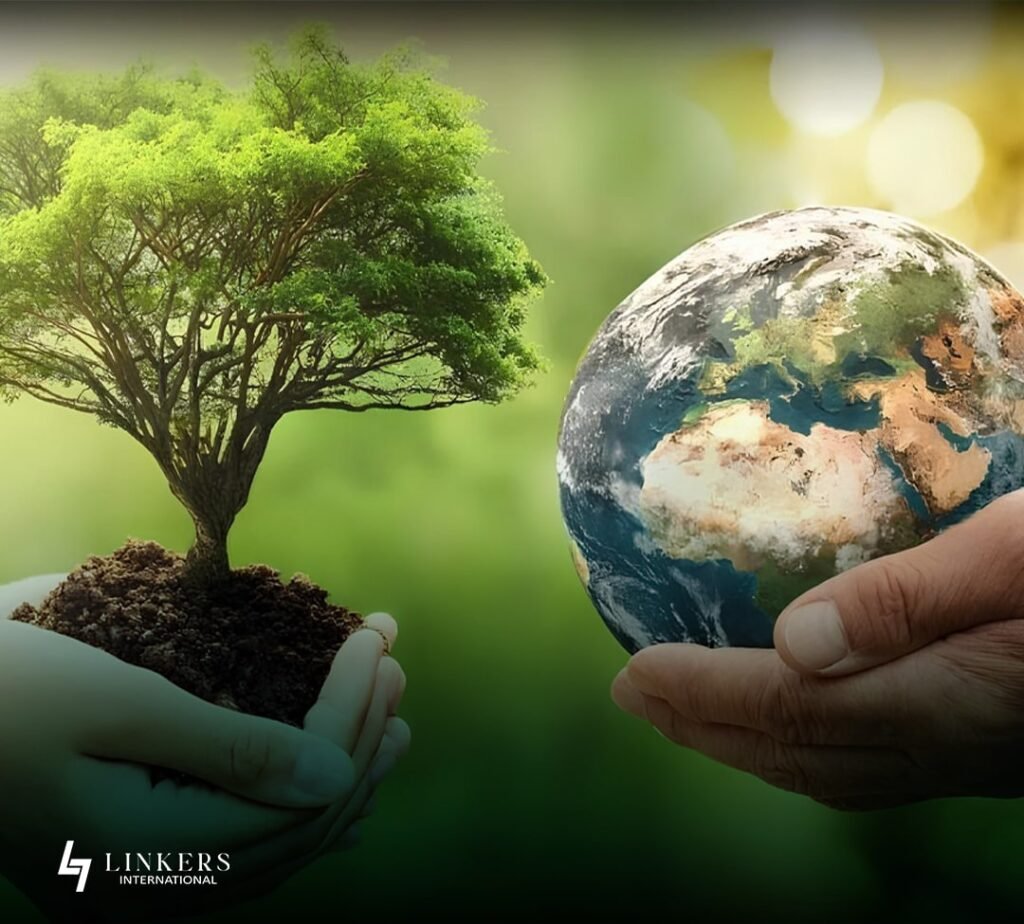
Even if our practices might yield short-term benefits, our constant reliance on such practices will yield long-term disadvantages. The way out is to adopt sustainable building practices, use smart urban planning, and develop climate-resilient designs. It’s time for developers, planners, and policymakers to make sustainability and responsible land use a priority in Pakistan. By focusing on responsible building today, we can create a real estate development model in Pakistan that grows the economy and protects the environment while building for a safer and more sustainable future.





